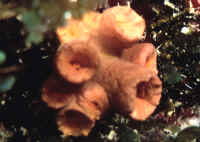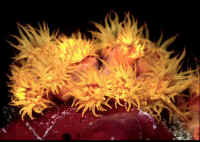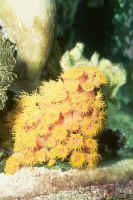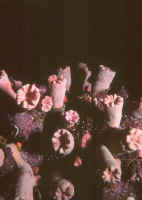|
Related FAQs: Dendrophylliids, Dendrophylliids 2, Dendrophylliid Identification, Dendrophylliid Behavior, Dendrophylliid Compatibility, Dendrophylliid Selection, Dendrophylliid Systems, Dendrophylliid Feeding, Dendrophylliid Disease, Dendrophylliid Reproduction, Stony/True Coral, Coral System Set-Up, Coral System Lighting, Stony Coral Identification, Stony Coral Selection, Coral Placement, Foods/Feeding/Nutrition, Disease/Health, Propagation, Growing Reef Corals, Stony Coral Behavior,
Related Articles: Large Polyp Stony
Corals, Stony or True Corals,
Order Scleractinia, Dyed
Corals,
/The Best Livestock For Your Reef Aquarium:
Pagoda, Sun, Cup Corals and More,
Family Dendrophylliidae, Part II
Part 1
Part 3,
Part 4
|
|
|
By Bob Fenner
|
Heteropsammia |
Genus Heteropsammia Milne Edwards & Haime 1848: /WA Corals:
free-living with keeled base that anchors into soft substrate • one or a
few corallites >2.5cm diameter
Genus Rhizopsammia Verrill 1870. From Joe Fish on FB:
"Note
how the polyps are seemingly disconnected from one another. They bud off
via stolons, which eventually become overgrown with benthic organisms
once the coenenchyme dies back. Tubastraea are far more cohesive...
basically built the same way as Dipsastraea."
Genus Tubastrea Lesson 1829: Azooxanthellate branching,
tree-like corals found in many places in the tropical and Indo-Pacific.
/WA Corals: distinctive dark green- black branching colonies • large
tubular corallites • can grow >1m in height • azooxanthellate
Due to feeding nature they require little light (non-photosynthetic),
but the aquarist must take care to see that each polyp is individually
fed as they are separate. About their biggest downside is the
mess keeping Tubastrea can entail. With heavy feedings of meaty foods
comes concurrent high nutrient levels. Often found in the wild in
caves, but also in direct sunlight. Most species are palm-sized,
composed of tubular polyps, with T. micrantha being the large
exception. Easily encouraged to produce new polyps by regular feedings,
especially when these foodstuffs are pre-soaked in a vitamin
preparation (like Selcon, Microvit...).
Tubastrea coccinea Lesson 1831, Orange
Cup Coral. Western Atlantic (introduced) and Indo-Pacific including the Red
Sea to Madagascar.
Told apart from T. faulkneri by having its polyps more closely situated. Right: Closed, open colony
pix in the Bahamas. Below, close up of a colony under an arch off
of Kailua Kona and exhibit images shot at the Waikiki
Aquarium. |
 
|
| Tubastrea faulkneri Variously sold as
Sun, Orange Cup/Turret, Sunflower, Sun
Polyps... Circumtropical distribution. Told apart from T. coccinea by
having its polyps more widely separated. A can-be kept species
if you constantly feed it, and can keep up with concurrent water
quality maintenance from the feeding. Shown at right in an aquarium
and the Red Sea by day. Below in Australia's Great Barrier Reef
during the night, Bunaken/Indonesia by day and Mexico's mid Sea
of Cortez at night. Predated by Epitonium billeeanum
(see below) |
 
|
Part 1
Part 3,
Part 4
|
|

